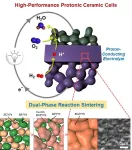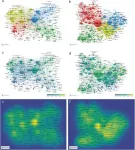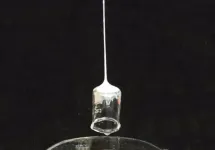(Press-News.org) Procrastination, sleep deprivation and reduced focus are part of the price we pay for free mobile apps. This is according to researchers at Linköping University and RISE, who have investigated the costs hidden behind the free apps. Based on their results, they also have some advice for decision-makers.
Most of us are becoming aware that our digital attention is hard currency for companies like Google and Facebook. By analysing our digital behaviour patterns, they can target tailored advertising directly to our feeds. Our attention becomes the product that is sold to advertisers. For example, YouTube’s three billion monthly users generated about €30 billion in revenue – mainly from services perceived as free.
Often, this data is collected through mobile applications that do not cost money to download and install. But according to researchers from LiU and RISE, there are more costs, in addition to personal data, associated with the free apps.
“Putting things off, procrastination, was the biggest hidden cost. But sleep deprivation, reduced focus and the apps taking time from physical contact with friends, hobbies and training, were also costs that arose. It can be difficult for users to put their finger on it at the time,” says Martin Mileros, PhD student at Linköping University and researcher at the research institute RISE.
The phenomenon the researchers are investigating is called the zero-price economy, which means that a service provider offers its services in exchange for the user’s data and attention without money changing hands. In traditional economics, the cost to the private individual corresponds to value for the company. But in the zero-price economy, cost and value are decoupled.
The researchers interviewed 196 people in Linköping around the university campus and the science park. Therefore, the selection cannot be said to representative of the entire population. The researchers still think, however, that they can get a good indication of how users view hidden costs and their personal data. According to the researchers, this is the first time users and their attitude to the zero-price economy has been examined in this way.
“We can see that many users value privacy and transparency highly. Furthermore, the study shows that users prefer to make one-time purchases of their favourite apps to protect their privacy over using services that are free, but which collect personal data,” says Martin Mileros.
In addition to more transparency from the companies, the researchers also want policy makers to place tougher demands on companies to disclose potential hidden costs.
“Many apps are designed to make us more or less dependent on them. Children and young people are particularly vulnerable. There should be stricter restrictions for many apps but also some sort of information about hidden costs. You might compare it to the graphic warning messages on cigarette packets. And for users, it’s important to understand these potential hidden costs and make more informed choices,” says Martin Mileros.
Although the findings of the study suggest that there are hidden costs, Martin Mileros still thinks that many users can get a lot of benefit and enjoyment from the free apps.
“You can find information, chat and so on. Also, you can change apps without much trouble if you don’t like something. So, it could be seen as a win-win situation where both companies and individuals benefit. But it’s easy to forget the other aspects of app use.”
END
The hidden costs of free apps – more than personal data
2024-10-10
ELSE PRESS RELEASES FROM THIS DATE:
Hot dragonfly summer: species with darker wings have evolved to withstand heat and attract partners
2024-10-10
Temperature determines where species can live and if they are threatened by a warming climate. So, for a long time, biologists studied how heat tolerance affects survival. Yet, less is known about how thermal traits influence reproduction, which is directly linked to extinction risk.
Now, researchers in the US have examined if males of dragonfly species that produce sexual signals in the form of dark coloration on their wings are more resistant to heat. They published their results in Frontiers in Ethology.
“We show that dragonfly species that have evolved dark breeding coloration on ...
Development of a new electrolyte synthesis method for next-generation fuel cells: a step closer to green hydrogen production
2024-10-10
Dr. Ho-Il Ji from the Hydrogen Energy Materials Research Center at the Korea Institute of Science and Technology (KIST, President Sang-Rok Oh), along with Professor Sihyuk Choi's team from Kumoh National Institute of Technology, announced that they have developed a new synthesis method that can significantly reduce the sintering temperature required for the densification process of the electrolyte in next-generation high-efficiency protonic ceramic cells.
Existing solid oxide cells (SOC) can produce electricity in fuel cell operation and hydrogen in ...
Rage clicks: Study shows how political outrage fuels social media engagement
2024-10-10
A new Tulane University study explains why politically charged content gets more engagement from those who disagree. Researchers found a “confrontation effect,” where people are more likely to interact with content that challenges their views than those that align with them.
The study analyzed data from Twitter, Facebook, and online experiments over time, including during the 2020 U.S. presidential election, and found that users frequently react to opposing viewpoints with heightened engagement, often ...
E-waste experts urge public: Stop trashing electronic products with ordinary garbage (International E-Waste Day)
2024-10-10
To mark the upcoming International E-Waste Day, Oct. 14, consumers worldwide are urged to collect dead and/or unused electronics and electrical products and give them a second life through reuse or repair, or recycle them properly.
Above all: stop tossing them out in household waste bins.
The Global E-waste Monitor 2024, authored by UNITAR in cooperation with ITU, reported almost a quarter of end-of-life electronic waste ends up in home trash, squandering billions of dollars worth of copper, gold and other precious metals, materials critical to the production of such products, along with valuable plastics, and glass.
The 14 million tonnes of ...
Hospitals that are understaffed for infection prevention and control have higher rates of infection, study says
2024-10-10
Hospitals that are Understaffed for Infection Prevention and Control Have Higher Rates of Infection, Study Says
Nearly 4 in 5 hospitals are not staffed at sufficient level to keep patients safe from preventable infections
Arlington, Va. — October 10, 2024 — Inadequate infection prevention and control staffing levels are associated with higher rates of healthcare-associated infections, according to a new study published today in the American Journal of Infection Control.
The study, conducted by the APIC Center for Research, Practice & Innovation, summarizes a pilot project to evaluate a new online calculator aimed at providing facility-specific recommendations ...
Study reveals 85% of women prefer choice between self-sampling and traditional cervical screening
2024-10-10
A new study led by researchers at Queen Mary University of London reveals women would welcome the option to choose between self-sampling and traditional screening done by a nurse or doctor for human papillomavirus (HPV)-based cervical screening.
The study, published in the Journal of Medical Screening, assessed a group of 2,300 women aged 24-65 who had collected their own samples alongside having their standard cervical screening in 38 GP practices across England. Participants were asked about their screening preference and their attitudes toward being offered a choice between ...
Global advances and future trends in cervical cancer research from 2013 to 2022
2024-10-10
With ongoing advancements in cervical cancer research, the global scientific community has gained a more comprehensive understanding of this significant threat to women's health. A research team led by Professor Weimin Kong has recently published a paper titled "Hotspots and frontiers in cervical cancer research: a bibliometric and visualization analysis from 2013 to 2022" in the internationally renowned journal Malignancy Spectrum. The study systematically analyzed the development trends and research hotspots in global cervical cancer research over the past decade using bibliometric methods.
The research ...
Inspired by Spider-Man, a lab recreates web-slinging technology
2024-10-10
Every kid who has read a comic book or watched a Spider-Man movie has tried to imagine what it would be like to shoot a web from their wrist, fly over streets, and pin down villains. Researchers at Tufts University took those imaginary scenes seriously and created the first web-slinging technology in which a fluid material can shoot from a needle, immediately solidify as a string, and adhere to and lift objects.
These sticky fibers, created at the Tufts University Silklab, come from silk moth cocoons, which are boiled in solution and broken down into their building block proteins called fibroin. ...
Applied Microbiology International’s 2024 Honorary Fellowship goes to Dr Chikwe Ihekweazu
2024-10-10
Applied Microbiology International (AMI) is delighted to announce that its 2024 Honorary Fellowship goes to Dr Chikwe Ihekweazu, who is Assistant Director General at the World Health Organization (WHO), leading the WHO Hub for Pandemic and Epidemic Intelligence.
AMI Honorary Fellowships are given to individuals who have made an outstanding contribution to or impact on the field of applied microbiology. Honorary Fellows of AMI are nominated and chosen each year by the organisation’s membership.
Chikwe ...
Pitt scientists validate new lab test platform for blood biomarkers of Alzheimer's disease
2024-10-10
University of Pittsburgh scientists independently validated a new blood test platform that can simultaneously measure more than a hundred biomarkers of Alzheimer's disease. The platform might improve clinicians’ ability to capture the multifaceted nature of Alzheimer’s pathology and streamline early disease diagnostics. The report was published in Molecular Neurodegeneration today.
“Alzheimer’s disease should not be looked at through one single lens,” said senior author Thomas Karikari, Ph.D., M.Sc., assistant professor of psychiatry at Pitt. “Capturing aspects of Alzheimer’s pathology in a panel of clinically validated biomarkers would increase ...









